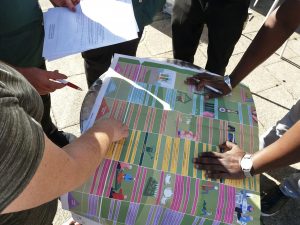No products in the basket.
Taking a Fresh Look at your Outside Space
Debbie Carroll and Mark Rendell are therapeutic garden designers who encourage care settings to take a fresh look at their care practices in order to engage actively and meaningfully with their outside spaces.
A few years ago they under-took an extensive research project to understand why care setting gardens were not used more actively, even when designed to the latest guidance, and particularly for dementia care settings.
This project took them on an extraordinary, and at times challenging, journey into understanding that the role of an organisation’s practices, attitudes and beliefs, its ‘care culture’, were key to understanding the level of engagement that residents had with their outside spaces.
Step Change Design Ltd was formed to uniquely support both the Care and Design sectors by sharing these findings.
‘Why Don’t We Go Into the Garden’ Map & Handbook (including free infographic poster)
This in-depth diagnostic programme offers care settings a practical way of understanding what is hindering engagement to outdoor spaces, and guides them to see what physical and cultural changes are needed to ensure a new garden design will support meaningful daily access.
The map visually shows how to plan a route forward to a more relationship-centred way of working where the garden is more of an extension to a home/care setting all year round. This ‘tool’ will also support garden designers to create a more dementia friendly garden in relation to current care practices.
Purchase the ‘Why Don’t We Go Into the Garden’ Map, handbook & infographic here
The ‘Why Don’t We Go Into the Garden’ A3 lnfographic poster is also available separately. It summarises some of the key findings of the research with insights and tips on how to make the most of time spent outdoors. The statistics come directly from their large scale research project carried out with support from NAPA and other care sector agencies.
Purchase the infographic poster here
The Research
“We amassed a lot of data during our large-scale research project back in 2013. With NAPA’s valued support, we recruited 17 care settings across England and Wales. with the majority of residents living with dementia, into our study to find out the answer to a pressing question we had:
Why aren’t care home gardens being used more actively?
“Our findings identified the central role that care culture played in influencing how well gardens were being used. We discovered that the more progressive the care culture was (i.e. person-centred or relationship-centred) the higher were the levels of engagement with the garden, regardless of whether it was designed. We also found that fearful attitudes towards Health and Safety effectively ‘capped ‘ engagement levels with the garden. This slowly evolved into our now familiar Care Culture Map and Handbook.
“What we hadn’t done until recently was to do a deeper analysis of the quantitative data (i.e. the numbers, quantities and amounts of activities and happenings in the study).
“Ten findings from this analysis activity stood out as being simple and achievable alterations to day to day care practices that would make a huge difference in engaging residents actively and meaningfully with their gardens. We were mindful that our work with care settings is primarily about encouraging behaviour change and so we felt sharing these findings would be best done via a colourful infographic poster.
“The infographic style also enabled us to distil the information into a series of simple but clear statements that can encourage someone to pause and reflect on what they do. The poster format works well as it is something that people can gather around (just like our Care Culture Map) and it can be displayed publicly for all to see.
“The poster can also help care settings compare their attitudes and practices towards the outdoors with other settings. For example, the average length of time spent outdoors per visit from our study was 41 minutes. In some cases, and in good weather, this was well over an hour.
“Even in the rain, almost 4 in 10 residents in our study spent time outside, if they wished. So the poster is also a subtle means to interrupt deeply held beliefs and attitudes about going outside and is a useful tool to aid reappraisal of an important and often neglected part of the overall care environment at the care setting. And for those homes that actively engage with the outdoors with their residents, the poster is a great way to display to everyone the positive value that is already placed on this important and health-enhancing space.
“We hope that the poster will be displayed prominently on notice boards so that residents, families, staff and managers can feel inspired by these tips and insights to enable fresh ideas about stepping outside or extending a visit to the garden. Above all, the poster articulates how simple changes to habits and routines, like taking a meal outside, or placing a bench along a path, can all help to create meaningful time spent outdoors for everyone at the care setting.
For more information about the work of Step Change Design please email Mark or Debbie at info@stepchange-design.co.uk
This article on the creation of the infographic was originally published in NAPA Living Life Magazine Autumn 2019.
Free to print out and share: our Garden Wordsearch





